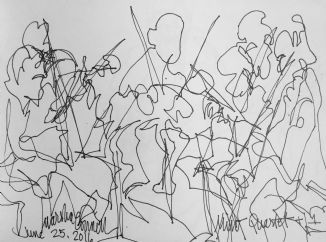|
Chamber
FRISSON DELIVERS SHIVERS OF DELIGHT
by Abby Wasserman
Sunday, March 30, 2025
Chamber
THE PARKER CAPTURES DEMANDING ADES QUARTET AT RAC SEBASTOPOL CONCERT
by Peter Lert
Saturday, February 15, 2025
Chamber
SPLENDID ECHOES ACROSS THE BAY
by Abby Wasserman
Sunday, February 9, 2025
ETHEREAL DUO IN WEILL HALL RECITAL
by Pamela Hicks Gailey
Thursday, February 6, 2025
ESPANA SEGURO AT SO CO PHIL'S JACKSON THEATER CONCERT
by Terry McNeill
Sunday, February 2, 2025
Choral and Vocal
MASTERFUL SINGING CLASS IN SCHROEDER HALL
by Pamela Hicks Gailey
Sunday, February 2, 2025
Recital
MUSICAL POT POURRI AT SPRING LAKE VILLAGE RECITAL
by Terry McNeill
Friday, January 31, 2025
CELLO AND CLARINET HIGHLIGHT TRIO NAVARRO'S CONCERT
by Ron Teplitz
Sunday, January 26, 2025
SONGS OF LOVE, IN A WARM TRIO
by Pamela Hicks Gailey
Sunday, January 26, 2025
Symphony
EARTHLY PLEASURES AT THE VALLEJO SYMPHONY
by Peter Lert
Sunday, January 19, 2025
|
 |
 Miró Quartet June 25 (Marsha Connell Sketch) |
ACROSS VAST SPACES
by Sonia Morse Tubridy
Thursday, June 23, 2016
Program number two of this summer’s ChamberFest at Schroeder Hall June 23 was all one could wish for, second to none. Jeffrey Kahane and Jon Kimura Parker returned to play together, this time on two pianos. As they engagingly explained, it is a completely different experience than playing four hands on one piano.
Mozart's D Major Sonata for Two Pianos, K. 448, finds the composer in high spirits. It is a work full of comedy, charm and wit. With two pianos there are wonderful feats of intertwining fast melodies that become possible and these partners on the keyboards rushed headlong into the overlapping themes and passagework. The resonant sound of two matched concert pianos filled the hall and surrounded the audience, an extreme orchestral sound bringing Mozart's duo from a light Fortepiano to the grand nineteenth century sound. The very brisk tempos gave a driving power to the two outer movements, sometimes heroic, others mock tragic. The Andante brought Mozart's sense of poetry and timelessness to balance the fireworks. The ensemble and unified interpretation were impeccable.
Following the intermission, the Miró Quartet, longtime favorites of the audience, took the stage with cellist Hai-Ye Ni. A lighthearted introduction by William Fedkenheur, expounding on second violinists, second programs, two cellos, Schubert's last two months of life and more coincidences, led one to performance of one of the greatest masterpieces in the history of classical composing: Schubert's String Quintet, D. 956. I suspect this performance will resonate for the audience for a long time. It was passionate in all extremes of emotion, understated, never rushed, and fully committed. For an hour, listeners and musicians were transported across vast musical spaces and into the depths of human sorrow and then transformed by hope and love. Schubert, in this qQuintet gives us his life and soul.
The first movement is symphonic in scale, and heartbreakingly poignant, intimate, and a song and dance emerging from pain. The inner voices in this interpretation were always alive. The Miró played in a beautifully textured and understated fashion that was spellbinding.
The second movement starts on the journey of mystery and moves through tears and sorrow, the void and hopelessness to love and comfort. A small voice speaks and grows strong. The beauty of melody and harmony is transcendent, a world one could want never to leave. It is hypnotic, an experience of mind and body. Throughout, the second cello added richness and depth to the ensemble, often with clear bells of pizzicato. The third movement with trumpet calls echo through the sonic fabric, where a sensation of bagpipes and drums are imitated and wipe out mournfulness. A serious and quiet prayerful song is heard and then energetic rhythms return.
The final movement is full of variety and in the hands of this ensemble and the subtle changes of mood and character flowed naturally. Dance and song wove their patterns, an elegant Viennese waltz, village revelry, a fluttering butterfly hovering in the first violin, clear and never overpowering the lyrical melodies in the other parts. Moving towards the end, rapid tempo and ever rising modulations sweep upwards to a triumphant finish. The audience had been silent throughout, but at the last tones rose shouting for a great ovation of appreciation.
All the performers, including the Miró’s Daniel Ching, John Largess and Joshua Gindale, returned to the stage for a spirited question and answer session with the audience.
Nicki Bell contributed to this review.
|

